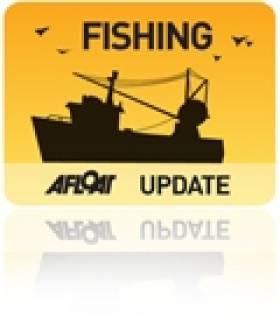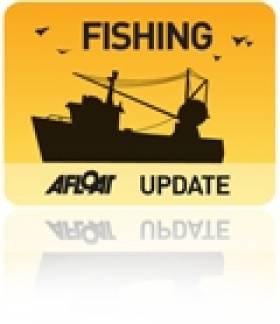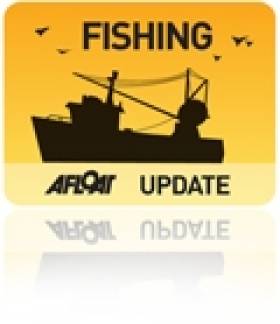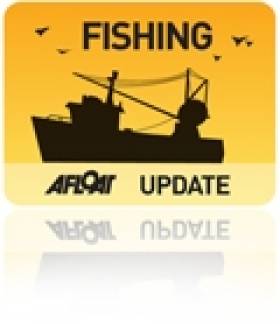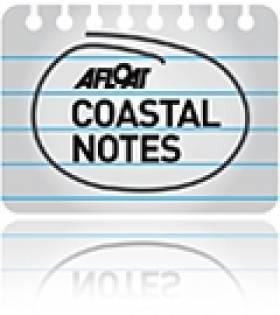Displaying items by tag: Simon Coveney
Quota Cuts of Up to Minus 64% Proposed for Key Whitefish Stocks
#whitefish – Minister for the Marine Simon Coveney TD., has expressed his serious concern at the major threat to Irelands' whitefish fleet, ahead of the upcoming EU Fisheries negotiations in Brussels. The Minister said that the Commission had produced a devastating and unnecessary set of the most severe whitefish quota cuts.
Minister Coveney said today that "If the Commission's quota proposals remain unchanged, we are facing an overall 20% cut to our whitefish and prawn quotas for 2015. In the Celtic Sea, the Commission wants to dramatically cut the key whitefish stocks on which our fleet are dependant".
The Commission's proposal is to cut Cod by -64%, Haddock by -41%, Pollack by -20%, Skates & Rays by -20%, Whiting by -14%, Monkfish by -12% and Hake by -4%. Minister Coveney said "There are also a number of other stocks where cuts of up to 20% are proposed without an acceptable justification. These levels of cuts are not justified and are not acceptable".
The Minister added that "I presented the scale and implications of these cuts to the joint Oireachtas Committee last week. (The Whitefish Fleet is facing a loss of 5,500 tonnes of whitefish quotas if the Commission's proposals are not modified at Council). The level of cuts proposed for the whitefish fisheries are extremely worrying. What is really unacceptable to me is the fact that many of these cuts are based on a very narrow interpretation of the available scientific advice and are, in my view, completely unjustified. I can accept reductions to quotas to protect the long term sustainability of our stocks but I will not accept scientifically unnecessary cuts that would undermine the sustainability of our fishing communities."
The Minister went on to say "I am frustrated with the Commission's whitefish quota proposals and I will, with the support of our industry representatives, other stakeholders and our scientists be arguing forcefully throughout the Council for a rational application of the scientific advice."
The Minister added that "I find it especially unacceptable that, in the context of the new Common Fisheries Policy and in particular the impending ban on discards, the Commission are taking such a rigid approach to the setting of quotas for 2015."
The Minister explained that " I am committed to setting quotas in accordance with Maximum Sustainable Yield (fMSY) but, in line with the agreement I brokered on the new Common Fisheries Policy, we must phase it in where it's immediate application would seriously jeopardize the social and economic fabric of the fishing fleets impacted. The Commission proposals assume its immediate application irrespective of the socio economic implications. This is not acceptable"
The Minister will attend the EU Fisheries Council in Brussels from the 15th to the 16th of December, where quotas for the Irish fleet for 2015 will be determined. The proposals put forward from the Commission impact the Irish white fish sector in particular with severe cuts in many stocks of vital importance to Ireland. The Commission has proposed cuts to pelagic stocks such as herring, mackerel, horse mackerel and boarfish. The Minister, working with our industry, is willing to accept these cuts on the basis they are justified on the available scientific advice.
Concluding, Minister Coveney said "This is my fourth December Fisheries Council and each year it seems to get more difficult. This year looks like being the most difficult one yet. I am extremely worried that despite our collective efforts we will be presented with a fait accompli of the worst set of cuts to our quotas in recent years. I will work as hard as I can with industry and other stakeholders, as well as important Member States such as France, the UK and Spain, to try and avoid that outcome. I am however very concerned that this will be an uphill task given the scale of the whitefish cuts being proposed."
International Fisheries Negotiations Hosted By Ireland
#fisherynegotiations – Ireland, on behalf of the European Union, is hosting important fisheries negotiations between Norway, Sweden, Denmark, Germany, Netherlands, Belgium, France, United Kingdom, Spain, Portugal and Ireland at the National Seafood Centre in Clonakilty, Co. Cork. These negotiations, on the annual fishing arrangements for 2015 between the European Union (EU) and Norway, commence at the National Seafood Centre in Clonakilty on Monday the 1st of December.
Minister Simon Coveney stated "I very much hope that we will have a successful outcome on the exchange of fishing quotas and access arrangements which will enable the finalisation of quotas for other stocks such as Blue Whiting off the north west of Ireland and the Herring in Norwegian waters which are of major importance to our west coast pelagic fishing fleet and fish processing plants in Donegal. My delegation will be pursuing Ireland's interests to the utmost during the talks."
Over seventy delegates from across Europe and Norway will meet at the National Seafood Centre in Clonakilty for the week long talks.
These negotiations cover a wide range of fish stocks across the North East Atlantic which are jointly managed by and shared between Norway and a range of EU Member States.
Economically, these negotiations are amongst the most important for the EU fishing industry, and this final round will focus on setting Total Allowable Catches for 2015 for a range of stocks, the sharing of these stocks between the parties and substantial quota swops between the EU and Norway as well as access arrangements to each of the respective areas for the parties. The outcome has a very direct effect on the opportunities available to Irish fishermen in 2015.
The Minister went on to say that "Once again, the National Seafood Centre in Clonakilty is the venue of choice to host these important international talks and helps in the overall aim of emphasizing Ireland's positive and proactive role within the European Union. Over seventy international delegates arriving in Clonakilty for a week in December will also bring a welcome boost to the local economy".
Cork Has 'Potential to be Global Yacht Racing Hub', IMERC Hears
#corkharbour – International yachting star Alex Thomson told an IMERC conference in Cork last night of the yachting opportunities for Cork Harbour. "I am delighted to be visiting Cork and working with the harbour here. I see Cork as a fantastic location for a global yacht racing hub with a perfect harbour allowing protection and natural depth as well as direct access to the Atlantic, the British sailor told the conference. 'We hope that we can support the growing ambition to develop something fantastic here in Cork harbour." The manager of Alex's team, Stewart Hosford added that "We are in discussion with Imerc to see how we can support Minister Coveney's ambitions for Cork Harbour. As a young boy who grew up sailing in Cork Harbour I am very excited about the opportunities for Cork and Ireland."
Last night's conference also heard that Ireland has a huge wave energy resource off its western coast with marine renewable energy potentially providing four times the amount of energy Ireland requires. Many companies are innovating in this space trying to find the technology that will harness the wave energy to make this a reality. Imerc is delighted to announce that one of those companies, Irish wave energy company Jospa, have won the Imerc Innovator of the Year Award.
Jospa have developed an Adjustable Break Fin technology that may double the output from wave energy devices at marginal extra cost. Jospa's technology could be the breakthrough wave energy needs if it is to meet its promise. A panel of high profile judges representing government and industry selected Jospa as the winner of the award.
Ian Venner, Partner at EY, who was a judge for the competition, said "Like all great innovations, the Jospa innovation is very simple but has the potential to have a profound impact on the wave energy sector. I will certainly keep an eye on how they progress over the coming months and years."
Joss Fitzsimons of Jospa, who design and make their own models and test equipment, said "The Imerc award is important for us as an acknowledgement of attainment through our careful progress. Good planning and engineering make it possible to approach success in wave energy without spending astronomic amounts. Based on a still-modest valuation, Jospa seeks investors of quite small amounts."
Budget Dishes Up €11.5m For Fishery Harbour Works
#budget2014 – The Minister for Agriculture, Food and the Marine Simon Coveney TD today announced details of his Department's 2015 budget. Emphasising that despite the fragile recovery in the economy, he had secured an increase in funding for the first time since 2009. Included in the funding of the Marine sector is the sum of €11.5 million devoted to the new seafood development programme 2015, while a further €11.5 million of capital funding will be invested in fishery harbour capital works, which not only adds value and improvement to these harbours but also contributes heavily to the local economies of the areas concerned. Some €6.3 million is allocated to investments in aquaculture and fish processing projects, while close to €47million is allocated to fund the marketing and development functions of BIM, the research role of the Marine Institute and the regulatory and control functions of the Seafood Protection Authority.
Coveney Secures EU Measures Against Russian Ban on Fisheries Imports
#fishing – Minister Simon Coveney TD, at today's EU Fisheries Council, secured the agreement of the Council and the Commission to bank a portion of this year's fishing quotas and transfer them into 2015. This measure will give the fishing industry the option of not fishing part of this year's quota and having it available in 2015. This measure will help mitigate the impact of the Russian ban on the importation of fishery products. The banking option will be applied to the mackerel, horse mackerel and Celtic Sea herring stocks as these are directly impacted by the Russian imports ban. The measure will be introduced shortly on the basis of positive scientific advice that it will not adversely impact on the sustainability of the stocks.
Minister Coveney said "I have listened to our industry and the difficulties those fishing Celtic Sea herring, mackerel and horse mackerel are experiencing because Russia has closed its important market to EU fishery products. The price for herring has dropped significantly for this autumn fishery and I want to give the industry the option of banking part of the quota until prices improve. I today secured the agreement of the Fisheries Council and the Commission to bank 25% of this year's quota until prices improve next year when market conditions have improved. I expect the Commission to receive the required scientific advice that the stocks will not be adversely impacted by this measure over the coming week so that the measures may be adopted in early November. "
Minister Coveney added "I made clear at Council today that we must recognise that we are dealing with a difficult situation for our fishing industry arising from a geo-political issue. We fully support the sanctions decision taken by the EU but must now provide as much support as possible to our fishing industry. The agreement I secured today at Council will give the industry some time and flexibility to find alternative markets while preserving Ireland's quota allocation."
Baltimore Sailing Club's Refurbished Clubhouse Opens
#baltimore – The village of Baltimore in West Cork was en fête yesterday (20th July 2014) with the opening of the newly-rebuilt clubhouse for Baltimore Sailing Club by Simon Coveney TD, Minister for Agriculture, Food, the Marine & Defence.
The opening follows a proposed Fáilte Ireland sale of the former Glenans sail training school premises in the West Cork town.
As Afloat.ie reported in April the new West Cork club house has been greatly welcomed by Irish sailing and yesterday, the scenic fishing village played host to hundreds of local and national sailors, visitors to the region and the local community, who were hugely supportive of the development of new Clubhouse and its facilities, which embraces all levels of sailing and encourages activity in the waters of the Carbery's 100 isles surrounding Baltimore. St. Fachtna's Silver Band from Skibbereen added to the carnival atmosphere, performing in the open air, with the stunning backdrop of Baltimore and the islands behind and boats of all shapes and sizes rafted up to complete the picture.
Minister Coveney stated: 'Baltimore is a very special place in West Cork, and the vibrancy is palpable from the moment one arrives here. There is an obvious high level of co-operation between the various groups in the village and its hinterland, culminating in the re-building of this impressive structure, offering outstanding facilities for locals and visitors. The Government and its agencies including West Cork Development Partnership, and Cork County Council, are delighted to lend support to the project, in the knowledge that it is significantly improving marine infrastructure in Baltimore. The Government has also supported the building of the new pier and service buildings in Baltimore, and I feel sure that, in the future, this harbour will see many new developments for the better in this wonderful part of west Cork'.
'This project is a testament to a fantastic volunteer effort by our members, supported by the people of Baltimore, and supporters and friends from many walks of life. In particular I'd like to pay tribute to Tony O'Driscoll, my predecessor as Commodore of the Club, whose relentless enthusiasm and hard work saw this project cross the line in jig time.' said Joan Collins, Commodore of the Baltimore Sailing Club.
Joan added: 'Baltimore has retained its friendly village atmosphere and this new clubhouse adds to the offering, with year round activity to encourage people to get on the water and enjoy the freedom of the waters of West Cork. The re-furbishment will be a great boost for our sailing fraternity, and we now have an option to host our events with style, while encouraging additional events which can only be of definite benefit to the Baltimore and greater West Cork area.
The Club is a vibrant and active summer club and has, and will, host several prestigious sailing events. With sailing every weekend throughout the summer and additional events out of season including at Easter (Laser Munsters), the National 18ft Class over June bank holiday weekend this year, and the Optimist Coaching week in February, we will hold many other great events later this year.'
Designed by architect John McCarthy and built by local builder, Michael Joe Leonard, the new Clubhouse space incorporates enhanced facilities for members and visiting sailors, including a new shower block (15 showers) and spaces facilitating events, training, seminars and storage and improved dingy parking. Totally transformed, and re-built at a cost of €400,000, the Club was supported by Cork County Council and West Cork Development Partnership, with match funding provided by the Club itself and by donations from members and the general public. Founded in 1952, Baltimore Sailing Club has over 600 members drawn from the locality and other regions, including several overseas members.
Baltimore is renowned for its sailing courses for children of all levels (85 children availing of this currently), and the Rambler Team Racing for junior club members is very popular again this year. Junior sailors from Crookhaven, Schull, Glandore and Baltimore are also involved in the inter-club Marconi Cup team racing event bringing communities closer together in the region. There is a course for adults in train this year also, and it is hoped to build on this offering into the future.
Sailing events in Baltimore include Baltimore Sailing Club Regatta will take place over the August bank holiday weekend, as will the 1720 Club. The inaugural WOMEN ON THE WATER (WOW) event on August 12th in aid of Breakthrough Cancer Research (part of Cork Cancer Research Centre) will see craft of all shapes and sizes on the water, with onshore fun for all the family. Sponsorship cards are available at the clubhouse and Commodore Collins is confident this event will raise a substantial amount for cancer research.
The Club will also participate in Bart's Bash, one of the first clubs in Ireland to register for this massive world-wide charity event. The clubhouse will also be used by local organisations such as the Baltimore Bridge Club, RNLI, local festival groups and defibrillator personnel, truly embracing all strands of society in the area.
#Addressing the 'Our Ocean Wealth Conference' today, Simon Coveney, TD, Minister for Agriculture, Food and the Marine outlined the significant progress made to date in implementing the Government's 2012 Harnessing Our Ocean Wealth: An Integrated Marine Plan for Ireland.
The Minister said "today's event brings together some of the most important figures in the Marine sector, and places it firmly in the spotlight as an industry with a significant economic and social contribution to make. It provides us with an opportunity to take stock of what has been achieved since Harnessing Our Ocean Wealth was published and to consider how to meet future opportunities and challenges".
Minister Coveney said that "I have spoken today about the many initiatives which have flowed directly or indirectly from HOOW. Integrating our marine policy is leading to significant results already but this is not a short term strategy. The target of doubling the percentage of GDP contributed by marine sector is an ambitious one but is more than achievable. Reaching those targets will depend on public and private sectors working collectively to make our ambitions for the sector a reality. We must be bold and radical in our ambitions for the sector and open to a range of new ideas".
In concluding his Address, Minister Coveney said that "HOOW has had some early successes in terms of implementation of the early actions identified in the plan but we must not underestimate the significant challenges which lie ahead. We can now finally envisage a potential golden era for Ireland's marine sector and today's conference is both timely and relevant in contributing to the pathways ahead towards a vibrant marine economy".
The Conference was opened by An Taoiseach, Enda Kenny, T.D. and included contributions from Minister Coveney, Pat Rabbitte, T.D., Minister for Communications, Energy and Natural Resources; Sean Sherlock, T.D., Minister for Research & Innovation; and Fergus O'Dowd, T.D., Minister of State at the Department of Communications, Energy and Natural Resources. Minister Susan Sullivan from the Government of Newfoundland /Labrador, Canada also spoke at the Conference.
The Keynote Address was delivered by Miguel Marques, Economy of the Sea: Executive Partner, PricewaterhouseCoopers on the subject of A Global Perspective on the Economy of the Sea. The Conference covered four main themes: The Global Opportunity for Irish Seafood; Research & Innovation and Emerging Sectors; Energy – Offshore Hydrocarbons and Where Land Meets the Sea – Opportunities and Challenges for Marine Tourism. Key speakers addressed these four themes followed by a panel discussion with relevant stakeholders.
The Conference is the first annual review of the Plan and was attended by over 400 delegates from the public and private sector with an involvement in the marine sector.
#oceanwealth - Addressing the 'Our Ocean Wealth Conference' today, Simon Coveney, TD, Minister for Agriculture, Food and the Marine outlined the significant progress made to date in implementing the Government's 2012 Harnessing Our Ocean Wealth: An Integrated Marine Plan for Ireland.
The Minister said "today's event brings together some of the most important figures in the Marine sector, and places it firmly in the spotlight as an industry with a significant economic and social contribution to make. It provides us with an opportunity to take stock of what has been achieved since Harnessing Our Ocean Wealth was published and to consider how to meet future opportunities and challenges".
Minister Coveney said that "I have spoken today about the many initiatives which have flowed directly or indirectly from HOOW. Integrating our marine policy is leading to significant results already but this is not a short term strategy. The target of doubling the percentage of GDP contributed by marine sector is an ambitious one but is more than achievable. Reaching those targets will depend on public and private sectors working collectively to make our ambitions for the sector a reality. We must be bold and radical in our ambitions for the sector and open to a range of new ideas".
In concluding his Address, Minister Coveney said that "HOOW has had some early successes in terms of implementation of the early actions identified in the plan but we must not underestimate the significant challenges which lie ahead. We can now finally envisage a potential golden era for Ireland's marine sector and today's conference is both timely and relevant in contributing to the pathways ahead towards a vibrant marine economy".
The Conference was opened by An Taoiseach, Enda Kenny, T.D. and included contributions from Minister Coveney, Pat Rabbitte, T.D., Minister for Communications, Energy and Natural Resources; Sean Sherlock, T.D., Minister for Research & Innovation; and Fergus O'Dowd, T.D., Minister of State at the Department of Communications, Energy and Natural Resources. Minister Susan Sullivan from the Government of Newfoundland /Labrador, Canada also spoke at the Conference.
The Keynote Address was delivered by Miguel Marques, Economy of the Sea: Executive Partner, PricewaterhouseCoopers on the subject of A Global Perspective on the Economy of the Sea. The Conference covered four main themes: The Global Opportunity for Irish Seafood; Research & Innovation and Emerging Sectors; Energy – Offshore Hydrocarbons and Where Land Meets the Sea – Opportunities and Challenges for Marine Tourism. Key speakers addressed these four themes followed by a panel discussion with relevant stakeholders.
The Conference is the first annual review of the Plan and was attended by over 400 delegates from the public and private sector with an involvement in the marine sector.
#seafood – Following months of intense lobbying and negotiation, Minister Coveney today secured €148 million from this fund for the period 2014 to 2020 for the development of the Irish seafood industry and the coastal communities that depend upon it. Welcoming this announcement the Minister said 'This funding is more than double the amount that was available to Ireland during the last Common Fisheries Policy (CFP) and will ensure a strong fishing industry in Ireland that can grow expand to meet its potential up to 2020."
In announcing the EU funding, Minister Coveney said "The new CFP is a major overhaul of the way which fishing is carried out in EU waters, the purpose of which is to provide a framework for the long term sustainability of fish stocks and the whole industry. The fund will provide support for our fishing fleet to meet the challenges of the new discards ban; it will support the development of the seafood processing sector, a sustainable aquaculture industry and the communities that depend on a vibrant seafood industry."
The Minister went on to say that "I am satisfied the €148 million which I was able to negotiate for Ireland from the new fund will help our seafood industry to develop and maintain long term sustainability and economic strength. This is more than double the amount of funding that was available to Ireland in the last period from 2007 to 2013 and is, I believe, the level of the investment needed to meet the challenges and opportunities facing the Irish seafood industry."
Ireland must now prepare a programme setting out the arrangements for spending the fund and submit this to the Commission by 20 October 2014. The Department has been working on the new Operational Programme since 2013 and has engaged with stakeholders on a number of occasions to date. Further public consultation and strategic environmental assessment will take place over the summer 2014. The Minister added "We have already being consulting stakeholders on the framework for the new programme. Now that we know the amount of funds we have available we can finalise these consultations and put in place an ambitious programme of support that delivers on the priorities of the fishing industry and other stakeholders."
Under the new CFP, which was negotiated to completion under the Irish Presidency of the EU in 2013, a European Maritime and Fisheries Fund has now been established to support the delivery of the new policy.
#dunmoreeast – The Minister for Agriculture, Food and the Marine, Simon Coveney TD, today announced details of a €4m dredging project at Dunmore East Fishery Harbour Centre on the occasion of the official opening of a €450,000 renovation of the Marine Leisure Area at the western end of the harbour.
At the opening, the Minister said "I am delighted to officially open this. The completion of this project adds greatly to the Harbour for marine activities generally. This end of the Harbour was in need of revamping for some time, and I prioritised works to make it a fit for purpose amenity which will benefit and promote the marine leisure industry in this area".
Leisure activity in Dunmore East has been increasing substantially in recent years with 180 visiting yachts from all over Ireland and abroad using the harbour in 2013, more than a threefold increase on previous years. Cruise line passengers nearly doubled in 2013 to 9,500 and with the newly renovated slipway it is expected that usage by members of the public will double in 2014 from around 600 in 2013.
The €450,000 renovation included extending the existing slipway, widening it from five to twelve metres, resurfacing and generally improving vehicle and pedestrian access, the development of a promenade with street lighting, improved access to the beach, and a rock armour embankment to protect the development from severe weather conditions.
Commenting on the works the Minister said "This is an excellent piece of infrastructure and is now a top class amenity which will lend itself to the further development of the leisure industry in Dunmore East, and the spin off that will have for tourism and jobs locally".
Announcing the €4m dredging project for Dunmore East to resolve the impacts of years of siltation in the harbour, which has restricted vessel traffic and made manoeuvrability and fish landings problematic for fishermen the Minister said "This significant investment in Dunmore East from the 2014 Fishery Harbour Capital Programme is an indication of this Government's commitment to the fishing industry in the South East. When complete, not only will the harbour be more accessible to larger vessels, landing times and management will be much improved as will the usability of the syncrolift".
Latest figures indicate that the value and volume of fish landings in Dunmore East has been on the increase for a number of years. Between 2010 and 2013 landings increased by 40% from 8,387 tonnes to an estimated 11,718 tonnes. The equivalent value of these landings went from €13.7m in 2010 to an estimated €17.5m in 2013 an increase of 28%.
The Minister went on to say "Taking account of the increased level of fish landings I am conscious of the need to dovetail the much needed dredging works with the seasonal work patterns of the fishing industry to cause as little disruption as possible. With that in mind every effort will be made to ensure that the works will be completed in advance of the important herring fishery later in the year".
Groundwork for the project is well advanced; a public procurement exercise will be initiated in May, with a view to awarding the contract in time for an August commencement date.
Concluding the Minister said "The development and upkeep of Dunmore East as a state of the art Fishery Harbour Centre, supporting a broad range of marine related activities is and will remain an ongoing process. These two major projects and the recent installation of floating pontoons within the Harbour are part of a long term strategy to deliver on the potential of Dunmore East for job creation for the fishing industry and as a marine leisure and tourist destination".




























